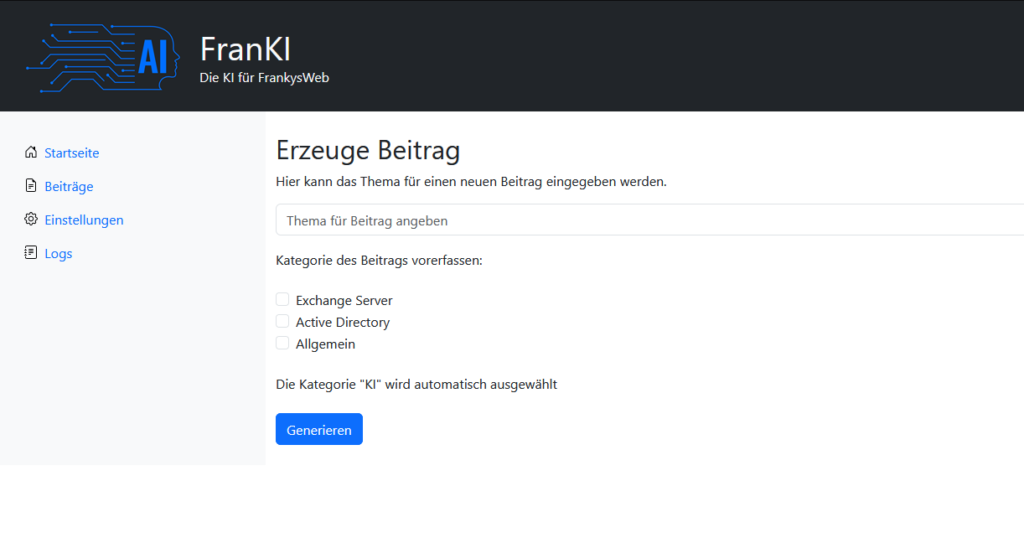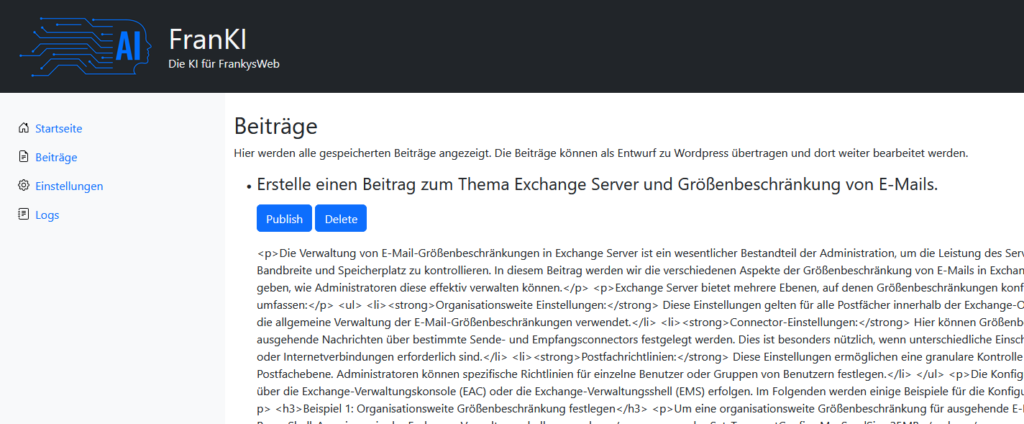I had already announcedthat I would like to test whether artificial intelligence (AI) can offer added value here. In the meantime, the idea has matured somewhat and I have realized that I have not defined "added value" at all. So I started thinking about the topic of "added value".
As the operator of this website, I am of course happy about views and visitors. It would therefore be an added value for me if more visitors land on my blog through the use of AI. I will probably also learn a lot from this experiment, which will generate added value for me at least.
On the other hand, "there are you", the readers of this blog. You may read one or two how-to articles here or (hopefully) find the solution to your problem. Of course, you expect articles that will help you and not some "AI-generated fantasy".
Many thanks to Tim, he immediately came up with a name for the AI: FranKI! I thought it was so funny that I adopted it straight away.
So that it is transparent which contributions were generated by an AI, there is a corresponding note under each article written by FranKI:

You also have the opportunity to rate FranKI's contributions. I would be delighted if you used the rating system and the comments. Feel free to write what bothers you or even something positive.
Each post also gets the category "AI", so I can find the posts better:

AI-generated posts can also be recognized by the author of the post: In this case, the author is always FranKI.
FranKI: The first test
I have started to develop the first version of FranKI. The first version uses Python and essentially the Python modules OpenAI and Flask. The Python module OpenAI makes it possible, as the name suggests, to use the OpenAI API via Python. With Flask is a web framework. To make the FranKI GUI look reasonably nice, I also use Bootstrap. This is what FranKI currently looks like:

At the moment, almost everything is manual: I specify a topic, for example "Create a post about Exchange Server and email size limits". The prompt and post request are sent to the OpenAI API and I can view the result a short time later:

The "Publish" button transfers the article to this blog via the WordPress API. Further manual work is then required:
- Set tags
- Create meta description
- Set keyword
- Publish article
You can see the first article for yourself here:
I don't think that's too bad for a first attempt. After all, the basic framework is in place, so you can build on that. Now I'll take a look at the prompts first and then try to automate manual steps further. I also need a nice logo :-)
So there is still a lot to do.
Update 10/23/2024: I will publish the development and current status of FranKI on a separate page. The new page can be found here.
Hi,
interessant, dass du da „so herum“ rangehst, ich hätte es eigentlich anders gedacht und sehe hier, wie bei vielen KI Projekten, den eigentlichen Nutzen von KI: als „neues Interface“ statt als Inhaltsgenerierung (außer vielleicht Bilder).
Ich kann mir z.B. vorstellen, dass du ein LLM trainierst mit deinen Blogartikeln und ich als Leser oder Suchender diese KI/Bot befragen kann und er mir die passenden Artikel raussucht. Der Unterschied zur Google-Suche mit einem site:frankysweb.de wäre, dass ich das in natürlicher Sprache machen kann, während ich bei Google schon abstrahieren muss. Also „Ich hab ein Problem mit einer Sophos XGS die mit Emails blockt, obwohl der SPF Eintrag richtig ist“ statt „Sophos XGS blocks mail SPF correct“ oder sowas. Die FranKI in meiner Welt würde dann die passenden Artikel verlinken und/oder schon eine kurze Antwort geben wie „Ja, da gibt es folgende Artikel, das liegt wohl an WAF Filtern. Nähere Infos hier: [LINK]“.
Wie gesagt sehe ich hier die eigentliche Zukunft, v.a. von LLMs: eine natürlichere Mensch-Maschine-Interaktion. Es ist zwar bei den meisten schon in Fleisch und Blut übergegangen ein Icon anzuklicken, dann evtl. STRG+A, STRG+C, Fenster zu wechseln und STRG+V zu machen, dann das Gerät zu wechseln und eine Nachricht in einen Chat zu diktieren. Aber ich stelle mir eben Star Trek mäßige Situationen vor a la „Computer, öffne den Ordner mit den bearbeiteten Urlaubsbildern. Kopiere sie in den Familien-Ordner. Versende eine Info an die Familiengruppe, dass ich die Fotos bearbeitet habe und sie die jetzt anschauen können“. Und im Hintergrund passiert eben das gleiche. Das mag aktuell auch länger dauern etc., aber in Zukunft wäre das auch in komplizierten Szenarien und spezielleren Programmen vorstellbar „Computer, öffne das Exchange Admin Center. Bearbeite die Größenbeschränkung für herausgehende Mails auf 200MB. Informiere Person X, dass das Ticket geschlossen wurde.“ usw., usw.
Soweit zu meiner Spinnerei :)
Top! Freut mich, dass dir der Vorschlag so gut gefällt, ich finde auch der Name passt prima! :)
Und das zwischen Ankündigung und erster KI-Artikel so wenig Zeit vergeht ist Wahnsinn!
Ich bin gespannt auf das, was da noch kommen wird, viel Erfolg!